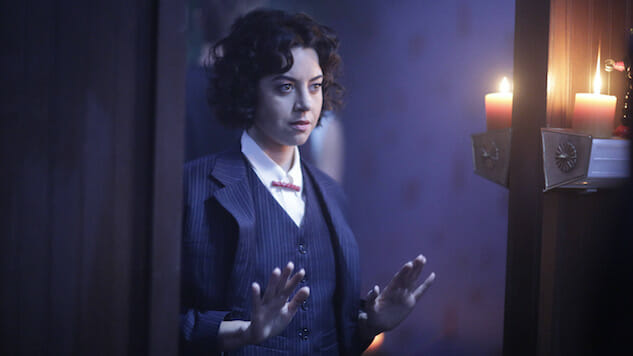Legion Might Be the Most Psychologically Complex Show on Television
(Episode 1.05)
Michelle Faye/FX TV Reviews Legion
Do you ever hang on, perhaps overzealously, to something from your childhood? Something so pure, so wholesome, so infused with an absolute sense of positivity that you know nothing could ever take away that safe, beautiful feeling you have when you think about it? If you’re like me, that thing might just be The Muppet’s “Rainbow Connection.” The very same “Rainbow Connection” that will now forever be a reminder of David (Dan Stevens) playing a banjo in a state of paralyzing fear, while leading Syd (Rachel Keller) on what can only be described as the world’s most high-stakes game of hide-and-seek.
I don’t bring this up to be bitter about the traumatizing use of a beloved classic—it certainly falls short of A Clockwork Orange’s now-infamous use of “Singin’ in the Rain.” Instead, I want to point out that Legion, while imperfect, might be the most psychologically complex show on television.
Thematically, “Chapter 5” focuses on the loss of innocence. David’s return from the astral plane marks a huge change in his personality. Stevens plays this new and decidedly sinister confidence with such wonderful sincerity that you may actually doubt if the personality change is actually happening. Gone is his fragile innocence; the poise that assumes its place is so serene and self-aware that you may be fooled into thinking all is well. Of course, that’s not the case. David’s loss of innocence, the loss of the fragility that’s such a large part of his character, isn’t really David. Yes, he’s “growing up” in his powers, but this is hardly a good thing, as it gives the creature inside him more control.
The loss of innocence is cast in a particularly bad light this episode. Syd recounts her first sexual experience, ending in some pretty horrifying implications. We see more interaction between Cary (Bill Irwin) and Kerry (Amber Midthunder), which leaves us with the sense that, while Kerry may be younger, she’s much more aware of life’s realities than the sheltered Cary. Amy (Katie Aselton) further corrupts David’s worldview by revealing secrets about their childhood.
Most telling of all is the literal Eden that David—or possibly not David, it’s hard to be sure—creates for himself and Syd. The white room is meant to be a place of purity, a safe haven where our star-crossed lovers can finally touch each other. It’s color-coded, with such a blinding white at the beginning that it could hardly be interpreted as anything else. The problem comes with that bug-infested bowl of strawberries. You know the one I’m talking about. It stands out starkly against the rest of the room, but we know just by looking at it that all is not as it seems. The illusion is already rotting from the inside.
In fact, the room changes significantly the next time we see it: When Syd and David return, the stark white is gone, replaced with an ominous neon blue. This scene culminates in what is clearly the episode’s tonal turning point. It follows immediately after Melanie Bird (Jean Smart) points out the change in David. It’s where Syd discusses her unfortunate first sexual encounter, and the way the shots are composed let us know there’s a problem here. Instead of the intimacy and connection such a conversation might reinforce, the images mostly emphasize how separate David and Syd are, even in the space created for them to share. They separate physically just a moment after Syd’s climax, and both seem to get lost in the bed, unable to see each other even as they search for connection.
Then there’s that red light. For a series that always turns on its unique visual style, the use of light, shadows and color here still seems to be on overdrive. Outside the ominous blue neon, we see the red outline of the “evil” bathroom where David and Lenny (Aubrey Plaza) plot to rescue Amy. A sickly green fills the corridors of Division 3 after David’s attack. Even creeping around David’s childhood home (itself a lost relic of his previous innocence), characters frequently move from shadow into light: From confusion, darkness, and silence— innocent to what they will soon face—to clarity, light, and noise; from the remnants of a mysterious house in the country to the clinical sterility of the Clockwork’s therapy group.
So how does “Rainbow Connection” play into this, beyond the now-standard use of a beloved children’s song for scares? Because everything Legion does, sometimes more effectively than others, is focused on creating empathy between the audience and David. Is David in love? Give the audience indie pop, Bollywood dance sequences, and high-saturation starlight. Is David confused? Use disjointed imagery and quick cuts to keep the audience from being able to fully grasp what’s happening. Is David worried to the point of nausea? Keep the camera constantly in motion so the audience’s eyes can’t settle on a fixed point.
Is David losing his innocence? Is everything he knows and loves being corrupted by the malevolent presence inside? Is that presence taking the pure, wholesome, positive parts of his childhood away from him? Guess what, audience, Legion needs to take something pure, wholesome and innocent from you, too. It’s going to have to be The Muppets, I’m afraid, because no one wants to lose faith in the rainbow connection—not David, and definitely not you.
Katherine Siegel is a Chicago-based writer and director, and a regular contributor to Paste. You can find out more by checking out her website or follow her on Twitter.